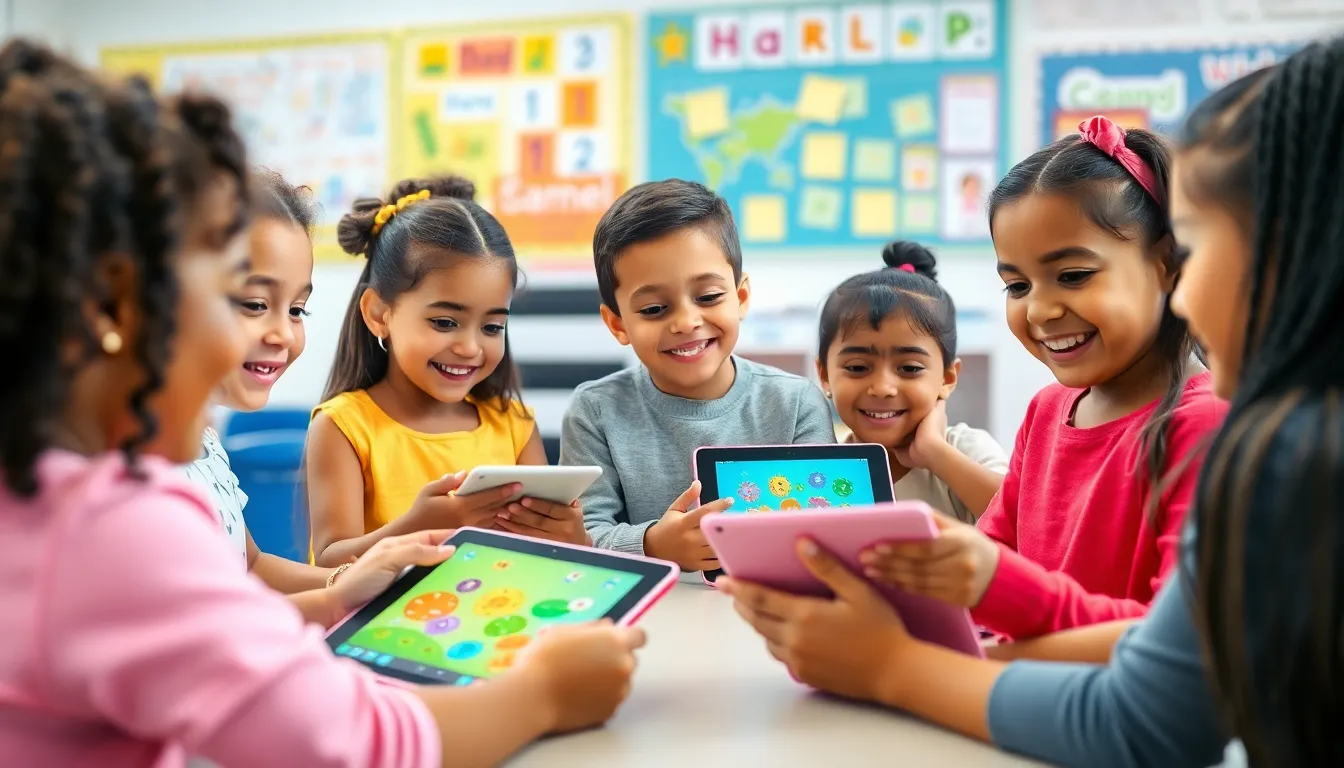In a world where kids can master a smartphone faster than they can tie their shoelaces, educational apps have emerged as the superheroes of learning. These digital wonders transform screen time into a treasure trove of knowledge, making math, reading, and science as exciting as a roller coaster ride. Who knew that learning could come with so many giggles and swipes?
Table of Contents
ToggleOverview of Children’s Educational Apps
Children’s educational apps have transformed learning for young users. These applications leverage technology to create engaging and interactive experiences. Subjects like math, reading, and science are presented in ways that maintain children’s interest.
Many apps utilize games to reinforce concepts. Players earn points or rewards for completing tasks, encouraging them to continue learning. Visual aids enhance understanding and retention. Interactive quizzes and puzzles promote critical thinking skills.
Available content varies widely. Some apps focus on language development through storytelling and vocabulary exercises. Others target math skills with problem-solving challenges and drills. Science applications often include experiments and explorations of concepts.
Parental involvement remains crucial. Many apps provide progress tracking, allowing parents to monitor their children’s learning development. Suggestions for app usage often accompany feedback, guiding parents in supporting educational efforts.
Diversity in the app market also exists. Programs cater to various age groups, from toddlers to pre-teens. Specialized content addresses different learning styles, ensuring broad accessibility.
Developing proficiency in technology is another advantage. Familiarity with digital tools can enhance students’ overall academic experience. Educational apps instill confidence in using technology effectively.
Overall, the rise of children’s educational apps showcases an innovative approach to learning. Utilizing digital platforms expands opportunities for personalized education and enables access to diverse resources.
Benefits of Children’s Educational Apps

Children’s educational apps enhance learning through interactive experiences and personalized content. By tapping into technology, these tools create an engaging environment that motivates young users.
Enhanced Learning Engagement
Enhanced learning engagement thrives in an interactive setting. Children respond positively to app-based challenges and reward systems that provide instant feedback. Educational games encourage participation, making subjects like math and reading enjoyable. Interactive elements such as animated characters and sounds capture attention and maintain interest. Additionally, curated content adapts to individual learning paces, enabling each child to progress without feeling overwhelmed. This dynamic approach fosters a sense of achievement that traditional methods often lack. Consequently, children become more invested in their learning experiences.
Development of Essential Skills
Development of essential skills occurs through diverse activities provided by educational apps. Children cultivate problem-solving abilities while navigating various challenges. Critical thinking often emerges in gameplay scenarios that require decision-making. Language skills improve through interactive storytelling and vocabulary-building exercises. Meanwhile, math concepts gain clarity via games focused on numbers and patterns. Each app generally emphasizes different domains, catering to unique educational needs. As users explore these resources, confidence grows alongside their skills. By integrating technology into the learning experience, children prepare for a digital world while enhancing their overall knowledge base.
Popular Categories of Children’s Educational Apps
Children’s educational apps span various categories, each offering unique ways to engage young learners. Categories include language, math, logic, and science, each tailored to specific developmental needs.
Language and Literacy Apps
Language and literacy apps emphasize reading skills and vocabulary development. Interactive storytelling engages children, enhancing comprehension through fun narratives. Vocabulary builders introduce new words in entertaining ways. Pronunciation practice facilitates correct speaking, fostering confidence in communication. Various levels accommodate diverse skill sets, ensuring accessibility for all learners. Engaging visuals and thoughtful illustrations stimulate imagination while reinforcing language skills, making learning fluid and enjoyable.
Math and Logic Apps
Math and logic apps focus on developing essential numerical and problem-solving skills. Many offer games that present concepts like addition, subtraction, and patterns through engaging challenges. Visual aids illustrate complex ideas, simplifying the learning process. Reward systems provide motivation, encouraging persistent practice. These apps cater to different proficiency levels, enabling children to progress at their pace. Features like timed challenges and puzzles introduce fun elements into learning, keeping children intrigued.
Science and Nature Apps
Science and nature apps inspire curiosity about the world. Interactive experiments allow children to explore biological and physical concepts firsthand. Observational skills improve as users engage with virtual ecosystems and nature-related activities. Many apps incorporate quizzes that reinforce understanding of scientific principles. Fun animations and sound effects captivate young audiences, enhancing retention of information. These tools cultivate a genuine interest in science, sparking potential future aspirations in the field.
Key Features to Look for in Educational Apps
When selecting educational apps for children, key features play a critical role in effective learning experiences. These features enhance usability and engagement while supporting diverse learning styles.
User-Friendly Interface
User-friendly interfaces promote accessibility for children of all ages. Intuitive navigation allows kids to explore apps independently, encouraging self-directed learning. Visual elements should be engaging yet simple, ensuring that the focus remains on educational content rather than technical difficulties. Bright colors and easily identifiable icons often help capture children’s attention, making it more likely for them to interact and learn. Additionally, feedback mechanisms such as notifications or rewards, effectively guide children through their learning journeys.
Interactive and Engaging Content
Interactive and engaging content captivates children’s interest and stimulates learning. Apps that include games, quizzes, and puzzles blend educational objectives with entertainment. These interactive elements encourage active participation, fostering deeper understanding of complex subjects. Children benefit from features that adapt to their skill level, providing personalized experiences that challenge them appropriately. Story-driven content can also enhance the educational value, supporting language development while keeping children engaged in the narrative. Dynamic animations and sound effects complement this interaction, creating a vibrant learning environment.
Recommendations for Parents
Selecting the right educational app plays a crucial role in enhancing a child’s learning experience. Parents must consider features, content, and age appropriateness when making a choice.
Choosing Age-Appropriate Apps
Identify apps tailored to your child’s age group. Apps designed for specific ages ensure content aligns with developmental milestones. Features like simple interfaces appeal to younger children, while more complex puzzles engage older kids. Research shows that age-appropriate materials foster deeper understanding and retention. Always check app ratings and reviews to gauge effectiveness and appropriateness. Many educational apps provide detailed descriptions, allowing parents to match content with their child’s learning style.
Balancing Screen Time
Establishing boundaries around screen time is essential for children’s well-being. Limiting usage to 30 minutes a day can promote a healthy balance between digital and physical activities. Setting aside particular times for app use encourages focus and reinforces learning concepts. Encourage breaks during app usage to allow for physical activity and social interactions. Parents should model smart device habits by using screens mindfully themselves. Engaging children in discussions about their app activities can further enrich their learning experiences without excessive screen time.
Children’s educational apps represent a significant advancement in how young learners engage with various subjects. By merging technology with education these apps create an interactive environment that fosters curiosity and enthusiasm for learning. Parents play a crucial role in guiding their children’s app usage ensuring a balanced approach to screen time.
As children explore these digital tools they not only enhance their academic skills but also develop essential competencies for the future. The diverse range of apps available caters to different learning styles and preferences making education more accessible than ever. Embracing this digital age can lead to a more enriched learning experience for children preparing them for success in an increasingly tech-driven world.



